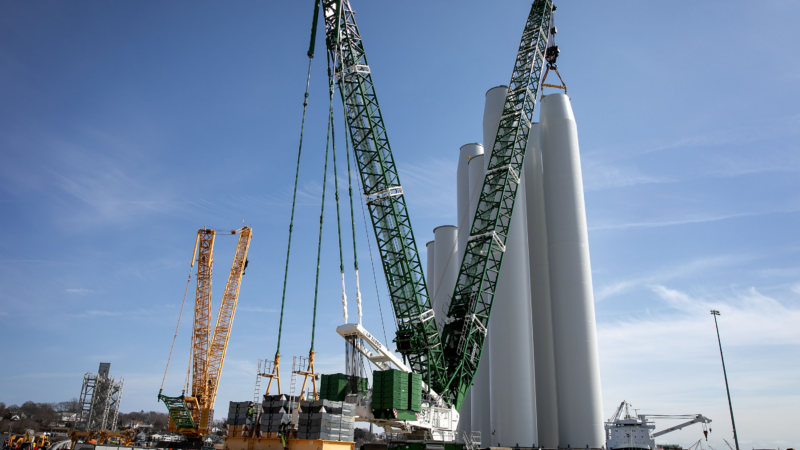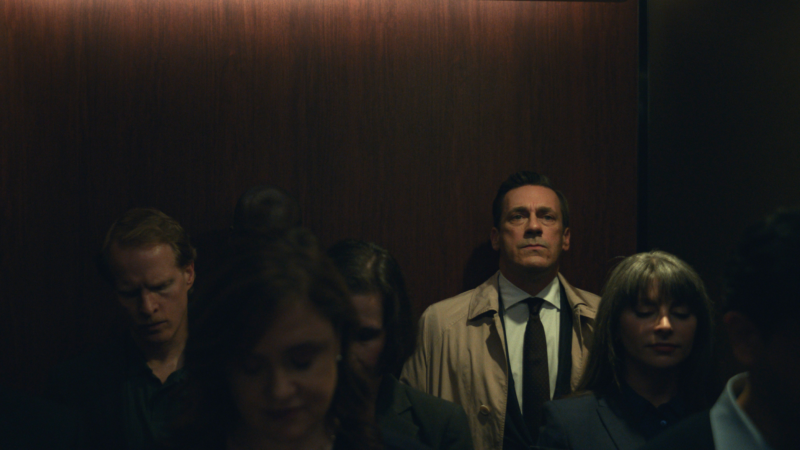Ukraine uses souped-up Soviet-era weapons to defend a vital river from Russia
KHERSON REGION, Ukraine — Just before dark, a half dozen Ukrainian soldiers clambered down a ramp into a trench hidden under a forested hill near the Dnipro River. They pulled back curtains of camouflage netting, revealing a massive armored vehicle.
“We call her Nike, after the Greek goddess of victory,” said the unit’s leader, a burly guy who goes by the military call sign Grizzly. “It’s a Soviet-made BMP-1TS that’s been modernized.”
Keeping full names secret is common protocol for Ukrainian soldiers. NPR agreed to use only their first names or call signs for security reasons.
Grizzly said during the day his team uses improvised bunkers to keep their weapons hidden from Russian drones and artillery that operate from the far side of the river.
By night, using an updated cannon mounted on Nike’s battered chassis — along with new navigation and targeting systems that allow them to work in darkness — they make raids along the riverbank, striking Russian positions.
“It’s performing really well,” Grizzly said proudly of the mobile cannon. “Very fast and maneuverable.”
Nike and the men who crew it are with the 1st Battalion of the 40th Coastal Defense Brigade. They form part of a dangerously thin line of Ukrainian soldiers that stretches along the roughly 600-mile front in the country’s almost three-year war with Russia.

Ukraine’s president, Volodymyr Zelenskyy, has acknowledged the situation for Ukraine’s military — trying to hold back Russia’s advance — has grown “extremely, extremely difficult and challenging.”
The mission along this section of the Dnipro River is to disrupt Russian operations that target the port city of Kherson and prevent amphibious assaults aimed at retaking the strategic city.
Why Kherson matters
Russian forces occupied Kherson in the early months of their full-scale invasion that began in February 2022. Ukraine liberated the city in November of that year.
Still home to at least 60,000 civilians — down from 300,000 before the war — the city remains one of the most dangerous places in Ukraine. Russian troops shell neighborhoods daily and send drones laden with bombs buzzing over the streets.
“Since the first day of this year alone, the enemy has attacked the region [with drones] about 650 times,” Oleksandr Prokudin, head of Kherson’s regional military government, said in a recent post on the Telegram social media app.

While Russia and Ukraine often clash over control of islands in the Dnipro River, Moscow hasn’t yet committed the number of troops, boats, artillery and other support that military analysts say would be needed to retake the city.
Roman Kostenko, a former military commander and current member of Ukraine’s parliament from the Kherson region with close ties to Ukraine’s army and intelligence services, told NPR that might change.
“We got information [in December] that Russia prepares their troops to attack us across the river,” Kostenko said. “Some people from the [Russian occupied] side of the river called me and told me they saw boats and people training in a lake.”
According to Kostenko, it’s clear the Kremlin hopes to retake Kherson to help establish control of the Black Sea and to support military operations in southern Ukraine toward Odesa, one of Ukraine’s most important cities.

While it appears Russia doesn’t yet have enough artillery, boats or troops capable of mounting a full-scale crossing of the Dnipro, Kostenko said Moscow’s decision-making is unpredictable.
“[Attacking across] the river in winter is illogical, yes,” he said. “But if [Russian President Vladimir] Putin makes a decision about capturing Kherson, it doesn’t matter for him. Russia can attack [anytime].”
The Ukrainian soldiers who patrol the riverbank on board Nike said they’re ready if that happens.
Nike’s gunner, a middle-aged man who identifies himself as Yurii, call sign Psycho, showed NPR the shells — each as long as a human hand — chained together so they can be fed quickly into the cannon.
“We work fast,” Yurii said. “We arrive at the river and we fire, emptying the gun in a minute, a minute and a half at most. Then I tell the driver, ‘Let’s get out of here.’ “

These hit-and-run tactics are designed to harass the Russians while keeping Ukraine’s dwindling reserve of experienced soldiers alive whenever possible.
“Our job is to destroy the Russians and keep them from advancing and taking more of our territory — and we are getting that done,” said the 1st Battalion’s commander, who goes by the call sign Karyi.
“We look forward to the Russians trying to attack us,” Karyi said. “It would give us a chance to destroy more of them.”
Despite his bold talk, however, Karyi symbolizes how hard-pressed Ukraine’s military has become after nearly three years of bitter fighting against Russia’s much larger force. At just 24, Karyi is in charge of defending this section of the Dnipro front after being wounded twice while fighting elsewhere.

Asked about his age and his ability to defend a city as crucial as Kherson, Karyi said, “I’m confident in my men, so I’m confident in myself.”
In the darkness, his men were making final preparations before setting out on the night’s mission, their breath showing in the light of their headlamps.
They carefully battened steel hatches and double-checked electronic gear designed to confuse Russian drones, which also have optics that make them capable of striking at night.
Nike rumbled to life, its powerful engines echoing over farm fields, as the unit prepared to move out.
Asked if they believe they can hold the line here, the gunner Yurii grinned and nodded. “Yes, yes, yes,” he said.
Nike’s driver, who goes by the call sign Mulfar, agreed, saying he no longer gets the jitters driving into the darkness each night to face the Russians. “We’ve gotten used to it,” he said.
“This is just what we do now,” Grizzly said. “This is our job.”

NPR field producers Polina Lytvynova and Hanna Palamarenko contributed reporting for this story.
Transcript:
JUANA SUMMERS, HOST:
In southern Ukraine, the riverside city of Kherson is a coveted prize for Russia. Russian troops shell neighborhoods daily and send drones buzzing over the streets. NPR’s Brian Mann spent time with one team of Ukrainian soldiers working under cover of darkness to disrupt Russian attacks.
(SOUNDBITE OF ENGINE RUMBLING)
BRIAN MANN, BYLINE: At dusk, an armored vehicle takes me along a rutted farm road near Kherson, a few miles from the bank of the Dnipro River. A Ukrainian soldier guided me here after NPR agreed not to reveal the exact location.
I’m Brian.
YURI: Yuri (ph).
MANN: Yuri? Good to see you.
VITALI: Vitali (ph).
MANN: Good to see you, Vitali.
In the early winter darkness, I meet a small unit of soldiers, middle-aged men mostly, in green wool caps and gloves and worn combat fatigues.
VITALI: (Non-English language spoken).
YURI: (Non-English language spoken).
MANN: They’re pulling back the camouflage netting, and we’re in a kind of half-trench here that’s dug back into a forested hillside. And as they pull up the curtain, there’s an enormous armored vehicle here hidden away.
GRIZZLY: (Non-English language spoken).
MANN: The unit’s leader is a burly guy who goes by the military call sign Grizzly (ph). Keeping real names secret is common protocol for Ukrainian soldiers. NPR has agreed to use only their first names or nicknames for security reasons. Grizzly tells me by day they keep their weapons carefully hidden from enemy drones and artillery.
(SOUNDBITE OF METAL CLANGING)
MANN: Can I come up?
GRIZZLY: Yes.
MANN: I climb up onto the steel deck of what looks at first like a tank. In fact, it’s part-armored troop carrier, part-mobile artillery.
GRIZZLY: (Non-English language spoken).
MANN: Grizzly tells me it’s a Soviet-era weapons system modernized by Ukrainian engineers with a better gun – a kind of machine gun cannon – and better electronics for targeting and navigation in darkness. It performs really well, Grizzly says. It’s fast and maneuverable.
(SOUNDBITE OF METAL RATTLING)
MANN: It’s also deadly. Yuri, the team’s gunner, digs through a box of shells, each one longer than my hand. They’re chained together so they can be fed quickly into the cannon.
YURI: (Non-English language spoken).
MANN: “We work fast,” Yuri tells me. “We arrive at the river, and we fire, emptying the gun in a minute, a minute-and-a-half at most. Then I tell the driver, let’s get out of here.” These kind of hit-and-run tactics are designed to harass the Russians and keep them off balance. But Ukrainian units like this one with the first battalion of the 40th Coastal Defense Brigade are dangerously outnumbered. They’ve been ordered to defend big sections of the Dnipro riverbank. I put the question to this battalion’s commander, who goes by the call sign Khari (ph) – can you hold Kherson?
KHARI: (Non-English language spoken).
MANN: “Our job is to destroy the Russians and keep them from advancing and taking more of our territory. And we’re getting that done,” Khari says. I ask him about a report shared with NPR by a Ukrainian official that Russia may be building up troops and boats for a major amphibious attack near Kherson.
KHARI: (Non-English language spoken).
MANN: “We look forward to the Russians trying to attack us. It would give us a chance to destroy more of them,” Khari says. It’s bold talk, but Khari himself symbolizes how thin Ukraine’s army is after years of fighting Russia.
Do you mind if I ask how old you are?
KHARI: (Non-English language spoken).
MANN: This battalion commander, charged with defending an entire sector of the Dnipro River, is just 24 years old.
You sound confident.
KHARI: (Non-English language spoken).
MANN: “I’m confident in my men, so I’m confident in myself,” Khari tells me. It’s full dark now. I can see the men’s breath in their head lamps as they make final preparations…
(SOUNDBITE OF HATCH CLICKING)
MANN: …Battening the armored hatches and making ready to roll out.
(SOUNDBITE OF ENGINE SPUTTERING)
MANN: I ask the men with this coastal defense unit if they think they can hold the Dnipro River.
YURI: (Non-English language spoken).
MANN: “Yes, we can hold,” Yuri tells me. I don’t hear doubts from any of these soldiers about their mission – driving out in darkness night after night to face the Russians.
Do you feel nervous?
UNIDENTIFIED PERSON #1: (Non-English language spoken).
UNIDENTIFIED PERSON #2: (Non-English language spoken).
UNIDENTIFIED PERSON #1: (Non-English language spoken).
MANN: “We’ve gotten used to it,” one of the soldiers says.
(SOUNDBITE OF ENGINE RUMBLING)
MANN: Another soldier says, “this is just what we do now. This is our job.” Brian Mann, NPR News, near the frontlines in Kherson.
(SOUNDBITE OF NXWORRIES SONG, “WHERE I GO (FEAT. H.E.R.)”)
Trump administration lays out its evidence for deporting activist Mahmoud Khalil
Khalil's attorneys say the government's case against their client largely rests on a single letter from Secretary of State Marco Rubio alleging that Khalil participated in "antisemitic" and "disruptive activities."
The Northeast bet big on offshore wind. Trump wants to halt the industry entirely
Northeast states have bet big on offshore wind to meet spiking power demand and drive economic growth. But the industry's future is much more uncertain under President Trump.
Jon Hamm puts a twist on his Don Draper swagger in ‘Your Friends & Neighbors’
Wealth comes lined with rage and melancholy in a new Apple TV+ series about a hedge-fund hotshot who loses his job and begins to steal from his suburban friends.
Tariff chaos sends some drivers racing to buy, while others pump the brakes
With tariffs on cars, materials and parts threatening to send auto prices up, some shoppers are racing to lock in vehicles at pre-tariff prices. Others plan to drive their current rides into the ground.
Trump administration changes course on in-person requirements for Social Security
After announcing social security recipients would be required to appear in-person at office locations, the Trump administration is now backtracking.
Inflation is cooling — but Trump’s tariffs could upend things
Consumer prices in March were up 2.4% from a year ago — a smaller annual increase than forecasters had expected. While President Trump has suspended many of his new tariffs, import taxes that remain could push prices higher in the months to come.









